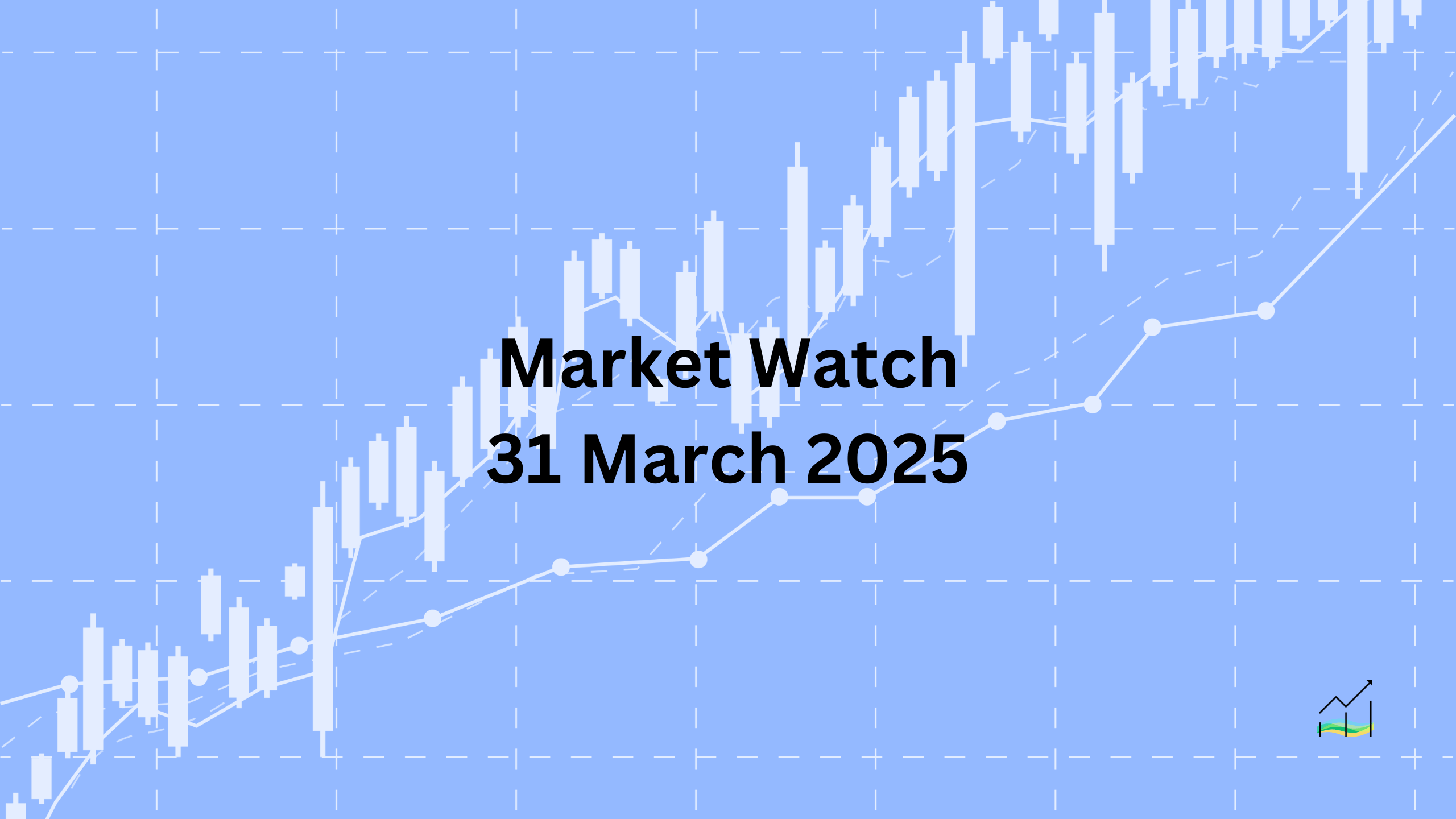31/03/2025 Market Watch

Dollar Strengthens Amid Market Turbulence from Tariffs
The US dollar started the week with gains, particularly strong against currencies from commodity-exporting countries like Australia, Canada, and New Zealand. Major currencies like the euro and the British pound remained stable, whereas the Japanese yen strengthened by about 0.5%, supported by a decline in US Treasury yields. Emerging market currencies showed mixed performance, with some Asian currencies, notably the Chinese yuan, appreciating. The Russian ruble weakened after threats of secondary tariffs on Russian oil if Moscow doesn't comply with ceasefire demands regarding Ukraine.
Equity markets across Asia suffered significant losses as investors reacted negatively to the heightened trade tensions initiated by the United States. Japan's Nikkei 225 and Taiwan’s Taiex both plunged by about 4%, while Australia's ASX 200 fell by 1.75%. Hong Kong's Hang Seng declined by 1.3%, and China's CSI 300 index dropped by 0.7%. European markets followed the downward trend, with the Stoxx 600 declining by nearly 1.3%, marking its fourth consecutive day of losses and surpassing the combined losses of the previous two sessions. US equity futures also suggest a weaker opening.
Investors seeking safety moved their capital into government bonds, resulting in lower yields globally. Japan's 10-year bond yield fell by five basis points to 1.48%, while European bond yields dropped by approximately 2 to 4 basis points. The US 10-year Treasury yield declined below 4.20%, a key threshold rarely breached since December. Meanwhile, gold prices reached a new record high, briefly nearing $3,128 per ounce, compared to $3,011 a week earlier. Oil prices remained steady, with West Texas Intermediate (WTI) futures trading slightly below $70 per barrel.
United States of America
Overview
The US dollar closed the week weaker, dropping to its lowest point as uncertainty around US tariffs, shifting capital flows, and upcoming labor data impacted investor confidence. Stocks, particularly in technology, suffered notable declines, while bonds gained due to increased risk aversion. Investors remain cautious as major economic reports and tariff deadlines approach.
Economic Drivers
The US dollar is influenced by ongoing trade tensions and shifts in international investment flows. President Trump's tariff threats have created uncertainty, leading investors to reconsider their positions.
- US reciprocal tariff threats, including potential exemptions and sector-specific tariffs (lumber, pharmaceuticals, copper, semiconductors), are increasing uncertainty.
- Capital is moving out of US equities, notably reversing significant European investments made last year, putting downward pressure on stock prices.
- Funds exiting equities are increasingly finding safety in US Treasury bonds, driving yields lower.
Data and Events
Markets are closely monitoring upcoming economic data and policy deadlines that could significantly influence market movements:
- April 2 deadline: Potential implementation of US reciprocal tariffs, possibly affecting multiple sectors.
- US labor market report: Expected payroll increase around 135,000 jobs, up from a previous forecast of 120,000. Investors remain wary of potential deterioration in the job market.
- Weekly initial jobless claims: Currently stable at a four-week moving average of 224,000, slightly higher than the recent 222,000. Any significant rise could signal increased stress in the labor market.
Price Action
Technically, the Dollar Index tested support near 103.75, and a clear break below this level could lead to a retest of recent lows near 103.15. US equities face further downside pressure, with the S&P 500 and NASDAQ experiencing sharp declines. Bonds continue to attract safe-haven flows, pushing the 10-year Treasury yield below the critical 4.20% threshold.
Key Points:
- US dollar weakened, testing critical support around 103.75.
- Tariff uncertainties and potential exemptions are causing market volatility.
- Significant capital outflows from US equities into Treasuries.
- Upcoming labor report anticipated; job growth expected at around 135k.
- Technical indicators suggest further downward potential in equities and bond yields.
Australia
Overview
The Australian dollar weakened significantly today, dropping to around $0.6255, marking its lowest level since early March. Traders are closely monitoring the upcoming Reserve Bank of Australia (RBA) meeting, although expectations suggest no immediate change in interest rates. Recent fiscal policy changes announced by the government ahead of the May elections are also influencing market sentiment.
Economic Drivers
The key factors impacting the Australian dollar right now include the RBA's cautious stance on monetary policy and recent adjustments in government fiscal policy:
- The RBA recently lowered its cash rate to 4.1% and has communicated a careful, patient approach going forward.
- The Australian government introduced a looser fiscal policy to stimulate the economy ahead of elections scheduled for May 3.
- Market expectations fully price in another rate cut by the RBA during its May 20 meeting, reflecting investor caution toward economic growth.
Data and Events
Market attention is primarily focused on upcoming events and announcements related to Australia's monetary policy:
- Reserve Bank of Australia Meeting – Scheduled for early tomorrow, where the bank is widely expected to keep rates unchanged at 4.1%.
- Australian Federal Election – Scheduled for May 3, with recent fiscal easing influencing investor outlook.
- Next RBA Meeting – Set for May 20, fully priced by markets to deliver another rate cut.
Price Action
Technically, the Australian dollar is trading near significant levels, with short-term moving averages (5-day and 20-day) converging around $0.6300. This price represents the midpoint of its recent two-month trading range of $0.6200–$0.6400. Traders will closely watch for any decisive move beyond these boundaries, as such a break would signal stronger momentum in either direction.
Key Points:
- Australian dollar fell to monthly low at $0.6255.
- RBA expected to maintain current rates at 4.1% tomorrow.
- Fiscal easing ahead of May elections adding to market caution.
- Next RBA rate cut fully expected on May 20.
- Key technical range remains between $0.6200 and $0.6400, with moving averages converging around $0.6300.
Canada
Overview
The US dollar strengthened against the Canadian dollar, breaking its recent downtrend and targeting higher levels around CAD 1.4400. This move comes amid growing uncertainty due to ongoing trade disputes and tariff threats from the US, raising concerns about Canada's economic outlook and potential recession risks.
Economic Drivers
The primary factors influencing this situation are related to trade tensions and economic expectations:
- Continued US tariffs on steel, aluminum, and automobiles, along with the threat of additional tariffs on sectors like lumber, are negatively impacting Canadian economic prospects.
- Economists have increased warnings of a potential recession in Canada due to ongoing trade uncertainty.
- Canada's economic growth is expected to slow significantly from 2.4% last year to about 1.5% in upcoming quarters, with further downside risks.
Data and Events
Several economic reports from Canada are scheduled for release this week. While important, these reports are unlikely to significantly influence investor decisions given the broader context of trade uncertainty:
- February Merchandise Trade Data – Will show Canada's trade balance prior to recent tariff shocks.
- Canadian Jobs Data – Scheduled at the week's end, which may briefly influence market headlines, though not significantly impacting broader sentiment.
Price Action
Technically, the US dollar’s recent rally above the key level of CAD 1.4350 signals potential further strength toward CAD 1.4400. The currency pair may even approach CAD 1.4550 without exiting the established monthly range, highlighting continued volatility within clear technical boundaries.
Key Points:
- US dollar broke recent downtrend against CAD, targeting CAD 1.4400.
- Ongoing US tariffs increase risk of recession for Canada's economy.
- Scheduled Canadian economic data (trade and employment) unlikely to shift market sentiment significantly.
- Economic growth projections for Canada remain subdued.
- Key technical levels: CAD 1.4350 support broken, potential rise towards CAD 1.4550 remains possible.
China
Overview
The US dollar's recent recovery against the Chinese yuan paused, falling to a five-day low near CNH 7.2530 after stalling near CNH 7.2825 last week. Market participants remain cautious, anticipating potential escalations in trade tensions between the US and China, especially with retaliatory tariffs possibly set for April 2. China is actively preparing its response, which has increased market uncertainty and prompted cautious trading.
Economic Drivers
The fundamental factors driving market sentiment currently revolve around escalating US-China trade tensions and Beijing’s recent economic measures:
- China is preparing countermeasures against potential US retaliatory tariffs, increasing uncertainty and risks of further market volatility.
- Beijing injected approximately $69 billion (CNY 500 billion) into its four major banks, reaffirming its commitment to economic stability.
- China's economic recovery remains fragile despite slight improvements, with PMI data showing modest growth in both manufacturing and services sectors.
Data and Events
Markets are closely watching specific upcoming events that could significantly influence trade dynamics:
- April 2 Deadline: Potential activation of US retaliatory tariffs on China, prompting expected Chinese countermeasures.
- US Trade Reports (Thursday): Key reports from US Commerce, Treasury, and the Trade Representative offices evaluating Chinese trade practices may trigger additional responses or tensions.
Price Action
From a technical standpoint, the dollar-yuan exchange rate recently failed to hold gains near the CNH 7.2825 level and has since drifted lower. Today's move down to CNH 7.2530 indicates technical weakness and suggests traders are hesitant to drive the dollar higher without clearer signals. Current trading around CNH 7.2700 reflects caution ahead of potential market disruptions from upcoming tariff announcements.
Key Points:
- Dollar-yuan recovery stalls, dropping to five-day lows near CNH 7.2530.
- Heightened risk of US-China tariff escalations around April 2.
- China injects substantial capital into major banks to bolster economic stability.
- Slight improvement in Chinese PMI indicates modest economic recovery.
- Upcoming US trade reports expected to influence market sentiment significantly.
Europe
Overview
After declining steadily from $1.0955 to around $1.0735, the euro rebounded, closing the week strongly near $1.0850. Markets remain cautious ahead of key European inflation data, while geopolitical developments—particularly concerning US trade policies, strategic decisions on Ukraine, and renewed tensions surrounding Greenland—are weighing heavily on investor sentiment.
Economic Drivers
The euro’s recent volatility is influenced primarily by heightened geopolitical uncertainties and trade policy shifts:
- US policy reversal on key global strategic issues, including Ukraine and Greenland, creating concerns over stability.
- Increased tension between the US, EU, and Russia regarding support for Ukraine and broader security decisions at the UN.
- US emphasis on controlling critical infrastructure and mineral investments in Ukraine, contributing to growing EU-US divergence.
Data and Events
This week’s inflation data across Europe could offer insights into the eurozone economy, although geopolitical concerns may overshadow their immediate impact:
- Germany and Italy CPI Reports: Scheduled for release today; these will follow recent CPI updates from France and Spain.
- Eurozone March CPI (Preliminary): Scheduled release tomorrow; expected to show slight declines in both headline and core inflation.
Price Action
From a technical viewpoint, the euro’s recovery to around $1.0850 retraced half of its recent losses. Immediate resistance levels are near $1.0860–$1.0870, and these areas will be closely watched for signals about the currency’s near-term direction. Continued trading within these bounds indicates ongoing investor caution.
Key Points:
- Euro recovered to $1.0850 after recent declines.
- Geopolitical uncertainty rises due to US strategic and territorial interests.
- US-EU divergences deepening over trade and security issues.
- Inflation data releases from Germany, Italy, and the broader eurozone this week.
- Technical resistance near $1.0860–$1.0870 critical for near-term price action.
Japan
Overview
The US dollar weakened significantly against the Japanese yen, reversing sharply from its recent high of JPY151.20 to below JPY149.00. This downturn was driven by falling US Treasury yields and positive economic signals from Japan, suggesting modest economic strength despite broader uncertainties.
Economic Drivers
Fundamental factors influencing this shift include declining US interest rates and improving Japanese economic data:
- US Treasury yields declined notably from recent highs (around 4.40%) to approximately 4.18%, weakening dollar appeal.
- Japan’s economic indicators showed improvement, with industrial production rebounding strongly in February (+2.5%) and retail sales showing consistent growth.
- Market sentiment is cautious due to ongoing global uncertainties, impacting investment decisions and currency valuations.
Data and Events
Markets will closely monitor important Japanese economic reports scheduled this week for further insights into economic sentiment and investment plans:
- Quarterly Tankan Survey – Scheduled for release early tomorrow, expected to show weaker sentiment among manufacturers due to ongoing trade uncertainties, while the services sector might remain relatively positive.
- Japanese GDP Forecast (Q1) – Economists project minimal quarterly growth of around 0.1%, highlighting cautious optimism.
Price Action
Technically, the US dollar posted a key reversal against the yen, falling sharply below the critical support level near JPY150.05 and testing the 50% retracement level around JPY148.90. If selling continues, the next key support to watch is around JPY148.30, marking a deeper retracement (61.8%) of the recent rally since March 11.
Key Points:
- Dollar reversed sharply from JPY151.20, dropping below JPY149.00.
- US Treasury yields fell significantly, currently around 4.18%.
- Positive Japanese economic data (industrial production and retail sales) supports yen strength.
- Quarterly Tankan Survey expected to reveal mixed business sentiment.
- Critical technical levels for USD/JPY at JPY148.90 and JPY148.30.
United Kingdom
Overview
The British pound struggled to sustain gains above $1.30 last week, signaling a potential weakening after a steady two-month rally. Despite bearish indicators suggesting a possible decline, the pound's pullbacks have so far been limited and quickly bought up by the market. Investors remain cautious, awaiting clearer signals from upcoming economic reports.
Economic Drivers
Sterling’s direction is currently influenced by moderate economic uncertainty and mixed indicators from the UK economy:
- Consumer credit and mortgage data released today had minimal market impact.
- UK consumer demand may be weakening, as shown by declining new car registrations over the past five months.
- Upcoming PMI data (manufacturing, services, and construction) will offer further clues about the UK’s economic momentum.
Data and Events
The UK economic calendar is relatively quiet this week, but markets will closely watch several key reports:
- March Final PMI Reports (manufacturing, services, and construction) – expected to provide insights into UK business conditions.
- March New Car Registrations – may reveal continuing weakness in consumer spending, given recent downward trends.
Price Action
Technically, the pound has encountered resistance around the $1.30 level. Momentum indicators suggest potential downside risk, though confirmation requires a clear break below the critical support level at $1.2860. Currently, sterling is trading within a narrow range ($1.2925–$1.2970), highlighting uncertainty and indecision among traders.
Key Points:
- Sterling faces resistance near $1.30 after a two-month rally.
- Limited market-moving UK data scheduled for the week.
- Declining new car registrations could indicate weakening consumer spending.
- PMI data awaited for clearer economic direction.
- Technical confirmation of downside risk requires a break below $1.2860.
© 2025 SKONE Enterprise (003319453-V). All rights reserved.
The content on this site is for informational purposes only and does not constitute financial advice.


